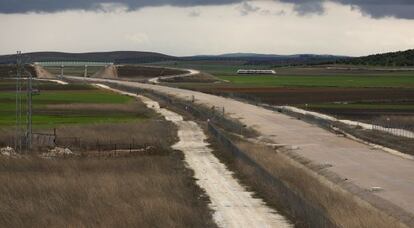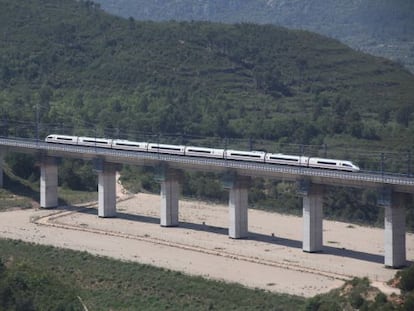Too much EU money down the drain?
Spain has benefited hugely from European funding, though many projects have been poorly planned Despite art centers sitting empty and railway lines lying unfinished, the EC says corruption is rare

“What were they thinking when they misspent European money?” asked the prime minister of one European Union member state during the 2012 bank bailout talks between Madrid and Brussels. Attitudes within the EU’s northern countries toward the perceived profligacy that led to the collapse of the property market in the southern periphery were perhaps best summed up by a cartoon in a German newspaper in 2008 featuring a Greek, a Spaniard and an Italian lying on the beach and demanding that their cowed-looking German companion buy them all a beer. But soon after Spain was plunged into an unprecedented financial crisis that awoke it from a dream largely financed with European money.
Inoperative desalination plants, empty arts centers, rail lines that go nowhere… Between 2007 and 2013, Spain received more than €23 billion from the European Regional Development Fund (ERDF), with just 61 percent of projects completed and paid back. During the same period, Spain was given €11.5 billion from the EU’s Social and Cohesion Funds. Almost all the money has been well-spent and accounted for, and has improved Spaniards’ quality of life and helped grow the economy. But this can’t hide the existence of corruption and negligence in making better use of EU money. The Anti-Fraud Office has already recommended that the EC ask Spain to return €250 million for allegedly exaggerating the cost of the stone used to build the El Musel port in Gijón.
We lacked a rigorous evaluation of the social worth of these investments, which explains why some absurd decisions were taken”
“We lacked a rigorous before-and-after evaluation of the social worth of these investments, which explains why there were some absurd decisions taken that were partially financed with European funds,” says Santiago Lago, a professor of applied economics at the University of Vigo and the author of several studies on the impact of EU funds. “They have certainly helped us move closer toward European standards of living, but we could have managed them much better,” he concludes.
Spain hasn’t only misspent EU money. The European Investment Bank has also been generous with Madrid: it pumped €130 million into a new port in A Coruña; along with a further €180 million into a stretch of the AVE high-speed rail line between Seville and Málaga, which had to be returned after the project costs overran.
The new port in A Coruña has its roots in the sinking of the Prestige oil tanker off the coast of Galicia, in northwestern Spain, in 2002. The environmental disaster prompted the government of the day, led by the Popular Party’s José María Aznar, to build a new port for La Coruña. The idea was to prevent any further danger to the city, which sits on a fjord, or ría, from vessels carrying fuel, and to do away with the need for the six-kilometer underwater oil pipeline. But the planners overlooked the question of how Repsol, Spain’s leading oil company, was going to transfer products from its current refinery to the new port. Twelve years on, Repsol remains at its old site. The EU pumped €267 billion into the project.
The projects have helped us move closer toward European standards of living, but we could have managed them much better”
Spain’s desalination plants provide a similar illustration of poor planning. In 2012, the then-agriculture minister Miguel Arias Cañete described the project as a “complete disaster”. After spending €1.6 billion on building 17 plants, they were working on average at less than 20 percent of their capacity. Brussels has since demanded Spain do something. Cañete has not mentioned the issue again, but the problem has not gone away. Two of the plants, in Ibiza and Menorca, are still not even operational, and remain unconnected to the mains water supply. In Barcelona, which was hit by severe water shortages in 2007 and 2008, the El Prat desalination plant, which cost €230 million, 75 percent of which came from EU funds, is functioning at just 10 percent of its capacity.
There are other examples involving smaller amounts of money. In Córdoba, in Andalusia, an arts center is still to be opened two years after construction work finished. It was funded with €27.3 million of ERDF funds. Granada’s Federico García Lorca center also remains unopened. Work was stopped when it was close to completion more than three years ago.
“Cases of misuse of EU funds are the minority,” says the European Commission’s office in Spain. A spokesman there explains that in the rare number of cases where fraud has been detected, such as stretches of the AVE rail route between Madrid and Barcelona, which have recently come to light, “we simply do not pay the money.” But the Commission says there are no specific studies carried out into how much corruption or poor planning costs EU tax payers.
With additional reporting by: Manuel Planelles, Daniel Cordero, Rafael Méndez, Andreu Manresa and Raúl Limón.
Tu suscripción se está usando en otro dispositivo
¿Quieres añadir otro usuario a tu suscripción?
Si continúas leyendo en este dispositivo, no se podrá leer en el otro.
FlechaTu suscripción se está usando en otro dispositivo y solo puedes acceder a EL PAÍS desde un dispositivo a la vez.
Si quieres compartir tu cuenta, cambia tu suscripción a la modalidad Premium, así podrás añadir otro usuario. Cada uno accederá con su propia cuenta de email, lo que os permitirá personalizar vuestra experiencia en EL PAÍS.
¿Tienes una suscripción de empresa? Accede aquí para contratar más cuentas.
En el caso de no saber quién está usando tu cuenta, te recomendamos cambiar tu contraseña aquí.
Si decides continuar compartiendo tu cuenta, este mensaje se mostrará en tu dispositivo y en el de la otra persona que está usando tu cuenta de forma indefinida, afectando a tu experiencia de lectura. Puedes consultar aquí los términos y condiciones de la suscripción digital.










































